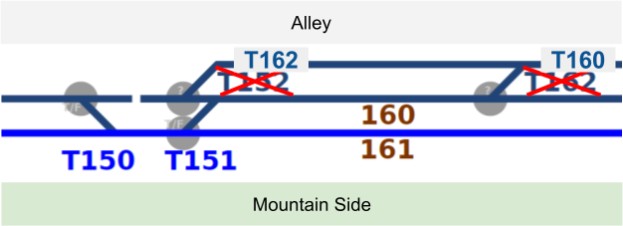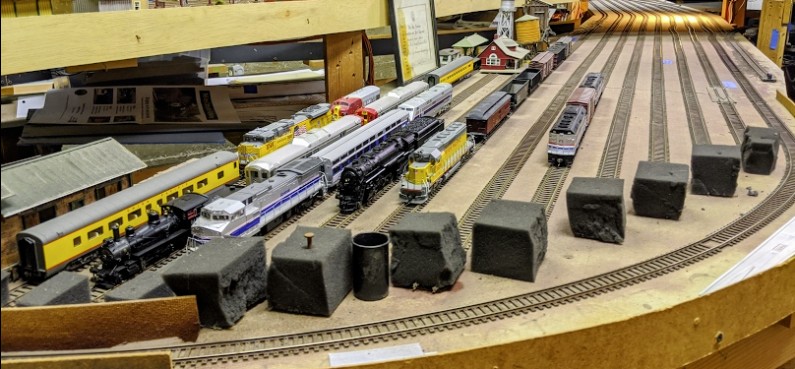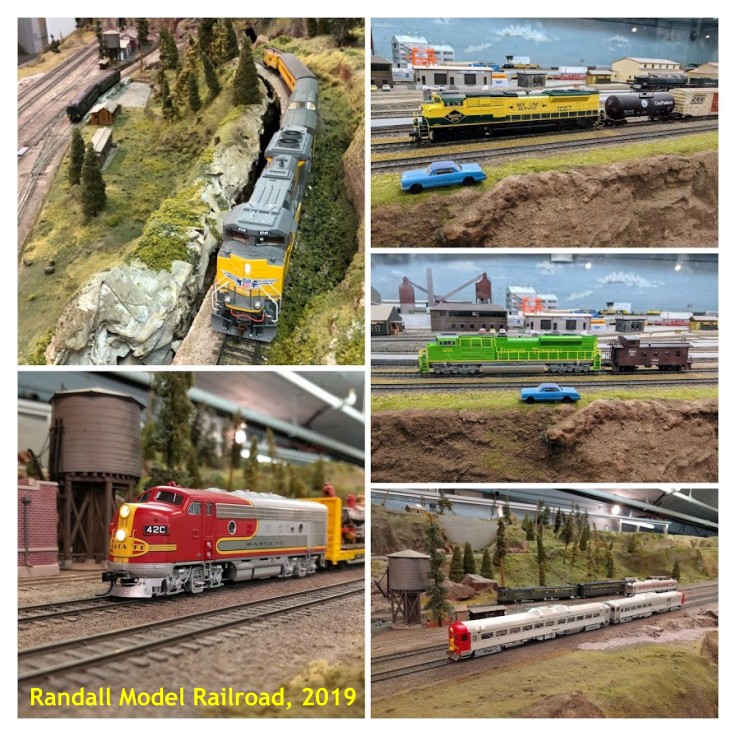The Randall Museum in San Francisco hosts a large HO-scale model model railroad. Created by the Golden Gate Model Railroad Club starting in 1961, the layout was donated to the Museum in 2015. Since then I have started automatizing trains running on the layout. I am also the model railroad maintainer. This blog describes various updates on the Randall project and I maintain a separate blog for all my electronics not directly related to Randall.
Now that I got the Napa yard fixed and working again, it’s time to use it for staging. Which means taking trains to and from the mainline..
“Let’s look at the track schematic on how to go from the yard to the mainline. The “normal forward” direction on the mainline (when operators run in a continuous loop) on this schema is from right to left:”
The turnout panel on the Valley is confusing and it’s never clear to me which toggle does what:
The layout has different types of turnout motors, which are annotated on my schema. The one above is hard to read, and zooming in reveals this (with turnout numbers corrected to match actual panels):
What this means:
Click here to continue reading...
2020-02-22 - Napa Yard Work
Category RandallWork has continued on the Napa Yard, and it is now operational again! I cut expansion gaps at the end of each track (before the foam block). On the other side, by the turnout ladder, I also made expansion gaps just before the turnouts for the 3 first tracks. This should prevent rail expansion from pushing the turnout rails and shorting like it did last time. Allen contributed and he helped clean the yard by vacuuming it and running the track cleaning train.
There’s still a bit of warping on the track under Bridgeport, in the area I was not able to access easily:
Click here to continue reading...
2020-02-01 - Work Updates
Category RandallLately I have been tackling several small tasks. In the category of “nothing to see, move along,'' I've been working on the Napa yard to prevent the track from warping again. I’ve made expansion gaps at the end of each yard track with a dremel tool. For the first three tracks that had the most warping, I have also made gaps next to the isolating rail joiner by the turnout ladder, at the other side of the track. No pictures to offer as these changes were rather anti-climatic.
I’ll continue another day as I need to similarly fix the Napa balloon track, and I need to fix a dead solder in the Napa yard track #3 while I’m at it.
Click here to continue reading...
Here’s the next thing to for Randall: explore creating turnouts using servos + arduinos, to replace the old twin-coils that fail in the yards.
Let’s take the example of the Stockton yard. The ladder has 8 tracks, and about 9 twin-coil turnouts. At least 2 of them are failing -- they do still throw, but they short. The panel uses route push-buttons that align the track turnouts and the two lead turnouts. There’s a diode matrix on a panel below the yard, and I have a schema for it somewhere in a piece of paper, although that one is simple enough to just recreate the matrix by hand.
Let’s say hypothetically I’d want to rebuild the turnout machines in that yard. What are the options?
Click here to continue reading...
2020-01-18 - DCC Flag Man
Category RandallI’ve got a set of DCC Flag Man and started using them on the layout, for example here on the siding for Sultan:
A DCC Flag Man protects the entrance of the tunnel siding at Sultan
On the other side of the tunnel, the crew is working on repairs:
Click here to continue reading...
2020-01-04 - Scenery Updates
Category RandallI found some time to use more of the vehicles and houses we got from Judy’s collection:
The buildings in the mountain and to the bottom left of the picture (next to the hotel) are from Judy’s collection, and they neatly fill some empty space. Technically the mountain has an access road, yet honestly it’s not visible from the visitors’ point of view. I believe I have seen some “shrubbery” green foam around that that I ‘d like to place around the buildings’ base to make them fit better. Gaps are very obvious from up close, not so much when seen from 5 yards away.
We also got this Amtrak train from Judy’s collection. I made a video which I have yet to finish editing. In the meanwhile, the train is stopped at the Fairfield station for everyone to look at:
Some people may want to snobbishly point out this train is not prototypical; I both fully agree and would ignore that. It’s a nice setup and I’d rather have it visible that sitting on a shelf. I also think the paint scheme nicely fits together. The train runs nicely too.
Click here to continue reading...
2020-01-01 - Happy New Year
Category RandallHappy New Year 2020 from the Randall Model Railroad team.
A collage of 2019 trains on the Randall Model Railroad.
Yesterday, I changed the freight train to use the 5278 NYC steam engine for the Polar Express. Jim put some labels on it. Also it’s worth nothing I’m not a fan of the Polar Express thing which I see mostly as a commercial effort, yet again it works for our audience, and that’s eventually what matters.
A NYC J-1 Hudson (4-6-4) pulls our Polar Express on the Automated Line on the HO Scale DCC Layout at Randall Museum, San Francisco.
Of note, I was having some issues with the sound on 5278.
Click here to continue reading...
We have not reestablished the GGMRC’s Junior Engineer Day (JED) at Randall since the re-opening in 2017. I originally had plans for it, and shoved them aside due to two reasons: one is technical, the other is staff involvement.
Click here to continue reading...








